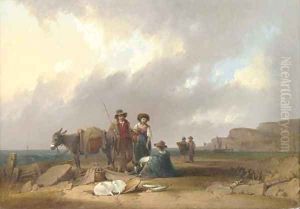William Sen Shayer Paintings
William Shayer was an English landscape and animal painter, born in Southampton, Hampshire, England, in 1788. He began his artistic career as a coach painter in his hometown but quickly turned to fine art, establishing himself primarily as a self-taught landscape artist. Shayer's works often depicted the lush countryside of Southern England, particularly the New Forest area, and he was known for his ability to convey the serene beauty of rural life during the 19th century.
Throughout his lifetime, Shayer developed a reputation for his detailed and picturesque landscapes, which frequently included figures and animals, demonstrating his skill in capturing both the human and animal form. His paintings often featured scenes of everyday rural activities, such as farming, hunting, and fishing, rendered with an appreciation for the natural environment and a keen eye for the changing seasons.
Shayer exhibited his work at prestigious institutions, including the British Institution and the Royal Academy, where his paintings were well-received. He became a popular artist of his day, and his works were sought after by art collectors and enthusiasts. Despite not having the formal training that many of his contemporaries had, Shayer's natural talent and dedication to his craft allowed him to enjoy a successful artistic career.
William Shayer was also a family man, with several of his children, including William Joseph Shayer, following in his footsteps and becoming artists themselves. Shayer's legacy continued through his children, who also achieved success in their own right.
William Shayer passed away in 1879, leaving behind a body of work that continues to be appreciated by art historians and collectors for its depiction of the English countryside and its reflection of 19th-century rural life. His paintings can be found in various art galleries and collections around the world, serving as a testament to his enduring appeal and the quality of his artistry.
